A few years ago, I spent a week in Yellowstone National Park. OMG, what an incredible place! I did a bunch of research about what to see before I went, but I couldn’t find much info on what to pack for Yellowstone.
Yellowstone presents some unique challenges for visitors. It is located in the Rocky Mountains and the park is at a high elevation. Most of it is over 7000 feet (2100m) above sea level and subject to unpredictable mountain weather.
I saw lots of unprepared people shivering in the cold, soaking wet in rainstorms or with lobster-like sunburned skin. (And to be honest, sometimes I was one of them.) Even though June, July, and August are summer in Yellowstone, it’s not like summer everywhere else in America!
To have an awesome time on your summer trip to Yellowstone, you should pack a few key items along with your regular travel gear. Below you’ll find a complete Yellowstone packing list for all visitors.
I also have a bonus list of what hikers should bring to Yellowstone and one for campers too. AND, I’ve got a Yellowstone packing list for picnickers. (Since I think picnicking in Yellowstone National Park is way better than eating at restaurants every day, and cheaper too.) [Insert your own Yogi Bear picnic basket joke here ;)]
In this post you’ll find:
- Things everyone needs to pack for Yellowstone
- Yellowstone packing list for hikers
- Yellowstone packing list for picnickers
- Yellowstone packing list for campers
- Things you don’t need to pack for Yellowstone
- How cold does it get in Yellowstone? (Weather and temperature info)
Hey there: Some of the links in this post are affiliate links, which means I earn a small commission at no cost to you. Thanks for your support. -Taryn
WANT MORE YELLOWSTONE INFO? Check out these posts:
- 70 Things to do in Yellowstone National Park
- Everything You Need to Know About Camping in Yellowstone
- Best Hikes in Yellowstone National Park
This is a sensitive wilderness area. Learn how to Leave No Trace to keep the wilderness wild. Make sure you are prepared by bringing the 10 Essentials. Get ready for adventure with this checklist of things to do before every hike.
The Basics: Things Everyone Needs to Bring to Yellowstone
Yellowstone is a unique place. It can be brutally sunny, cold and wet… all in the same afternoon. The wildlife watching is spectacular… and they are also not to be messed with. It’s also pretty remote.
While there are a few small stores in the park, they don’t have everything. I found it helped to be self-sufficient. Here’s my list of the things I think every single visitor to Yellowstone should pack.
Sun Protection
The sun can be really harsh in Yellowstone since it’s at such a high elevation. Bring a wide-brimmed hat or baseball cap for protection. You’ll also want lots of high SPF sunscreen and some SPF lip balm to avoid burned lips.
I used my Outdoor Research Oasis Sun Hat in Yellowstone since it has a wide brim and I can fold it up into my pack when I’m not wearing it.
READ NEXT: Tips for Hiking in Hot Weather
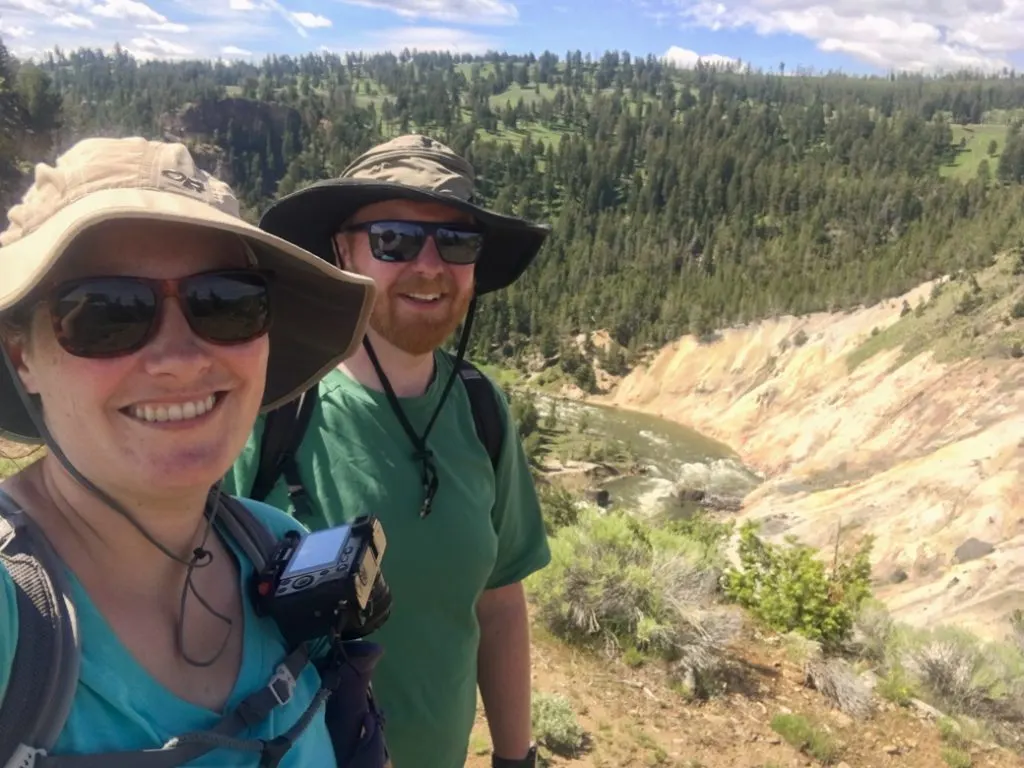
Polarized Sunglasses
I like to wear polarized sunglasses as they let you see colours that are truer to reality than what you get with regular sunglasses. They also help you see into the water.
In Yellowstone, that lets you see deeper into the hot pools and lakes, which is really cool. I like Goodr sunglasses since they have fun frame options and they aren’t too expensive for polarized glasses.
Camera with a Long Lens
The main reasons people come to Yellowstone are the amazing scenery and abundant wildlife. And of course, you’ll want photos of both. Your phone is fine for shots of scenery, but for wildlife, you’ll want an SLR camera with a long lens.
I’m the biggest idiot and forgot mine at home! I was cursing myself the whole time I was in Yellowstone as I missed out on some amazing wildlife shots. And if you are shooting with a long lens, you’ll want a tripod for stability. (I forgot that at home too! Oops.)
I did remember to bring my Sony A6400 camera. It’s a mirrorless camera which is more compact than a full DSLR but still produces high-quality images. I find it easy to use, plus it’s not that expensive.
When I remember to bring it, I use a budget Sony 55-200m lens to shoot wildlife. I also have a lightweight Sirui T-025SK carbon fiber tripod.
Binoculars or Spotting Scope
I’ve never seen more people carrying binoculars than I did in Yosemite. Binoculars are essential for watching wildlife since you need to stay so far away from them for safety. My advice would be to get the most powerful binoculars or spotting scope you can afford. It really makes a difference.
If you’re like me and know nothing about shopping for binoculars, check out this post on the best travel binoculars for wildlife watching.
We brought a compact GoSky Titan monocular that my husband found on Amazon. It’s pretty compact and not too expensive, but it still has great magnification. Our favourite part is that it comes with an adapter to attach your phone. That way you can turn it into a giant zoom lens for your cell phone. Pretty cool!
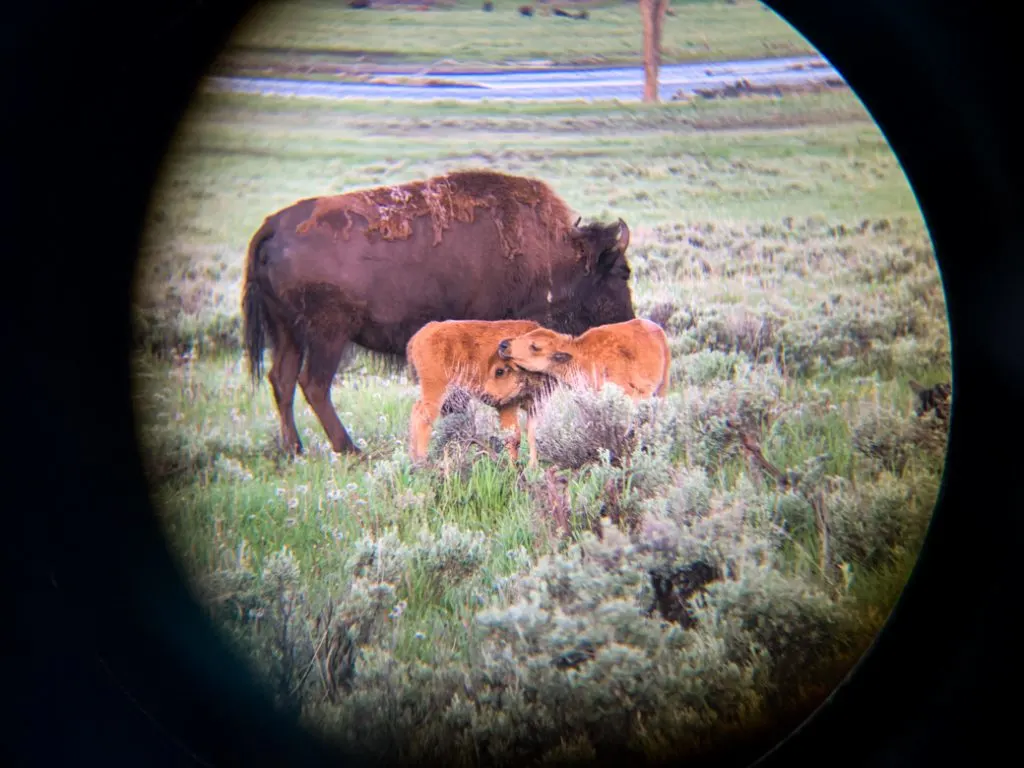
Bear Spray
Yellowstone has a very high population of both grizzly bears and black bears. While both species usually stay away from people, they have been known to prowl through campgrounds, defend their cubs, or surprise people on trails. I saw both grizzlies and black bears on my trip – a grizzly bear walked right past our backcountry campsite one night after dinner!
Carry bear spray and make lots of noise when hiking. You can buy bear spray at most stores inside Yellowstone National Park, but it’s MUCH more expensive compared to buying it beforehand.
Buy bear spray and make sure you get a a holster so you can attach it to your backpack or belt.
READ NEXT: Bear Safety for Hikers, Campers and Backpackers
Fleece or Puffy Jacket
Even if you visit in the middle of summer, Yellowstone can be chilly since it’s over 6000 feet (1800 meters) above sea level. Pack a cozy fleece or puffy jacket to wear for cold mornings and evenings. On my visit in mid-June, I ended up wearing mine at some point every day.
My husband brought his Patagonia Nano Puff insulated jacket. It packs down super-small but still has plenty of warmth.
I packed my favourite MEC Rockwall fleece, which I love since it is soft and has a bit of stretch. But any fleece jacket will do. You also can’t go wrong with the budget-friendly REI Trailmade Fleece.
Reusable Water Bottle and Travel Mug
You need to stay hydrated at high elevations. But adding plastic waste to our world sucks. Bring your own reusable water bottle and fill up at visitor centres, hotels, and campgrounds.
I don’t go anywhere without my Hydroflask. (My husband jokes that it’s my emotional support water bottle!) It keeps my water cold all day, which makes it worth the price.
If you’re a coffee drinker, it also makes sense to bring your own mug to avoid a throw-away paper cup. Plus that way your coffee stays warm longer. I love my YETI Rambler Tumbler. It keeps coffee hot for hours and the magnetic slider lid keeps it closed. It’s also easy to disable the lid to clean it.
Phone and Power Bank
These days, we all take our phones everywhere. So, of course, you’ll want yours in Yellowstone. Keep in mind that there is no cell service in most of the park, and in the areas where there is coverage, it can get spotty.
This means that your phone battery will die quickly while it keeps looking for a signal. (And also because of all those geyser videos you’ll be taking!) Make sure you bring a portable power bank so you can charge your phone on the go.
I use a tiny Anker power bank that charges my phone a couple of times. Unlike some of the crappy power banks you can buy on Amazon (or at gas stations) these are high quality – I’ve had mine for years and it’s still going strong.
Toilet Paper and Hand Sanitizer
There are lots of toilets around Yellowstone National Park. Most parking lots and trailheads have one. However, the toilets don’t always have a good supply of toilet paper and hand sanitizer. Keep some with you just in case.
And if you really need to go and can’t make it to a toilet, go to the bathroom the Leave No Trace way: Dig a small hole 70 big steps away from trails, roads, campsites, and water. Then bury your waste, and pack out your toilet paper in a plastic bag. I carry a super lightweight titanium trowel for backcountry poo-mergencies. Hilariously, it’s called the Deuce of Spades.
Bug Spray
The mosquitos in Yellowstone can be bad, especially in early summer. If you’re sensitive to bites, bring some insect repellent. I use bug spray made with picaridin since it is scientifically proven to be the most effective and isn’t as harsh as DEET. Skip the herbal and citronella insect repellents – they don’t work.
Rain Jacket
Yellowstone still gets rain in the summertime. It’s very common for thunderstorms to spring up in the afternoon, leading to a quick (and intense) rain showers.
Bring a lightweight rain jacket just in case you get caught in the rain. I love my Mountain Hardwear Minimizer Gore-Tex Paclite Plus Jacket since it is insanely light, packs down super-small and breathes well. The only downside is that it’s not cheap.
If you’re looking for a budget-friendly packable rain jacket I recommend the Outdoor Research Helium or the REI Rainier.
READ NEXT: 5 Tips for Hiking in the Rain
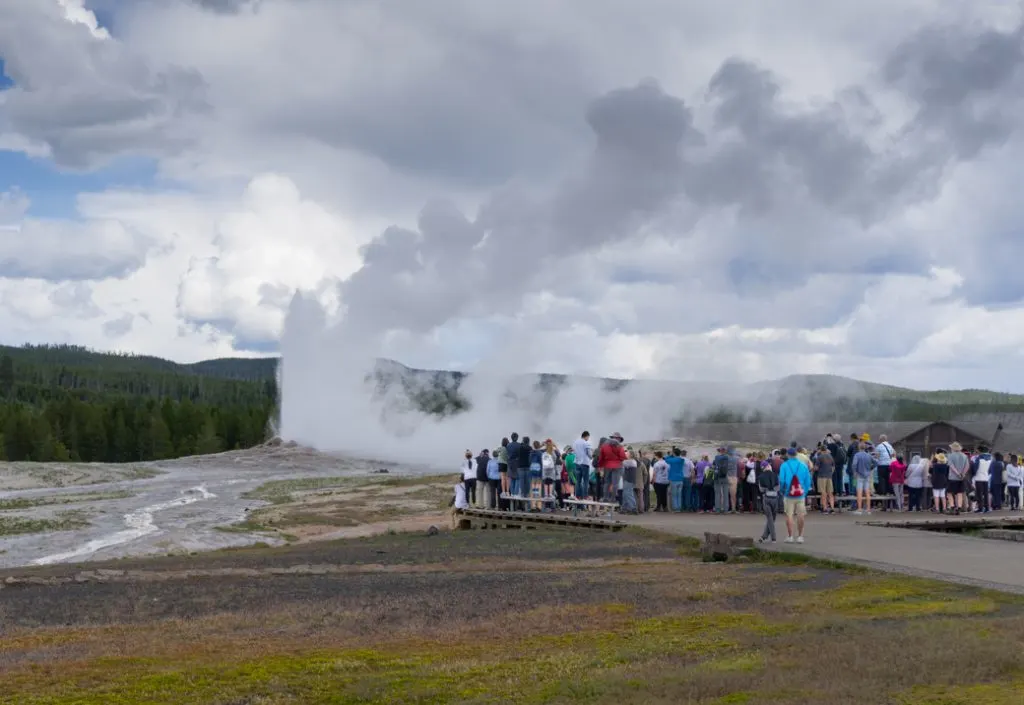
First Aid Kit
You can buy basic first aid supplies at stores in the park. But that won’t seem like a good option when the nearest one is 30 minutes away and someone needs a bandaid or a Tylenol. Pack a basic first aid kit. Make sure it includes bandages, gauze, and medical tape.
You’ll also want to have lots of foot care supplies such as Moleskin or Second Skin for blisters. (Check out my full list of blister care and prevention tips and tricks.)
Bring anti-inflammatory painkillers like Advil, and anti-diarrhea pills like Immodium just in case. And don’t forget your usual prescription medications.
I like the Adventure Medical Ultralight first aid kits since they come in a water-resistant pouch. I always add more stuff to them, like more blister care and bandaids.
Bathing Suit and Quick-Dry Towel (Optional)
If you’re visiting during the warm summer months, bring a bathing suit so you can cool off in one of Yellowstone’s two swimming areas: Boiling River and Firehole River. Due to high water levels and strong currents, both of these spots are usually closed until early July, so I wasn’t able to swim on my mid-June visit. Some of the hotels in the area also have pools or hot tubs.
Don’t bring a traditional cotton beach towel – they take up tons of space and take forever to dry. I use a quick-drying microfibre travel towel from PackTowl. It absorbs lots of water and dries really fast.
Moisturizer (Optional)
If you come from a humid, coastal climate like me, you will find the high mountain air really drying. My skin complained for our entire visit! I wish I had brought some good moisturizer.
Fishing Gear (Optional)
Fishing is REALLY popular in Yellowstone. If you want to fish, you need to get a special Yellowstone fishing permit and comply with tackle restrictions. My husband didn’t bring his fishing gear since we didn’t think we’d have time to fish. He was definitely jealous of all the fly fishers we saw!
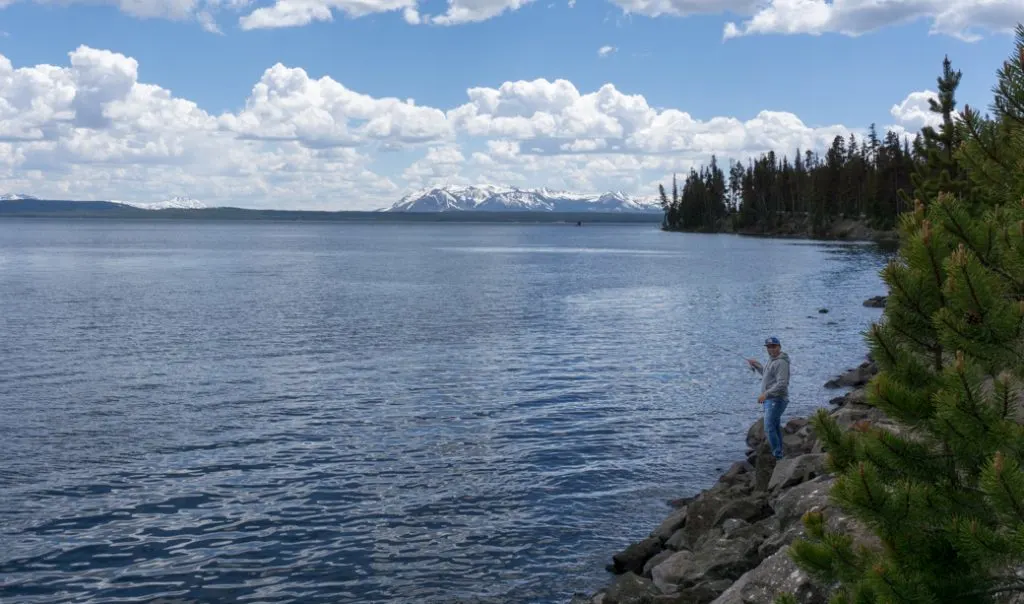
Dog Leash (If Applicable)
You can bring your dog to Yellowstone, but it has to be on a short leash (less than 6 feet) at all times. Dogs must also stay within 100 feet of roads, parking lots and campgrounds. That means your dog can’t hike with you or visit any of the thermal features.
You can find more info about visiting Yellowstone with dogs on the National Park website.
Hiking Gear to Pack for Yellowstone National Park
Yellowstone has TONS of hiking trails. Most visitors stick to the roadside pullouts and never venture on to a trail. That means the hiking trails are MUCH less crowded than the rest of the park.
If you’re planning to go hiking in Yellowstone, you’ll need to pack the 10 essentials, just as you would on any hike. But here are a few other things you should bring for your Yellowstone hike.
READ NEXT: The 10 Essentials: Things You Should Bring on Every Hike
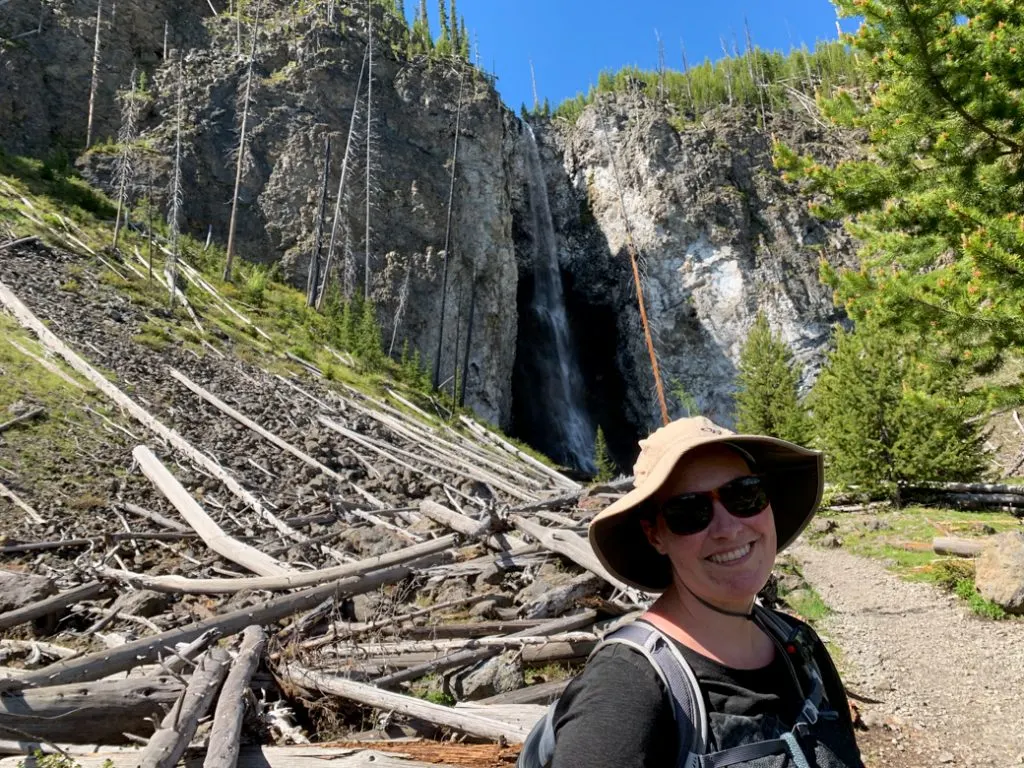
Day Pack
If you’re going hiking, you’ll need a backpack to carry your gear. You can use any old backpack you have lying around the house. But I find it much more comfortable to hike with a dedicated hiking backpack.
For day hikes, I like ones that have about 20 litres of capacity and have a spot to hold my hydration reservoir. I also love ones with hip belt pockets so I can easily grab snacks, lip balm or my phone without taking the pack off.
I’ve been using a Gregory Maya for years and absolutely love it! It’s a women’s pack but it comes in a men’s version too called the Miko.
Hiking Boots
The trails in Yellowstone are pretty well maintained, but they can be steep or muddy. Wearing hiking boots gives you ankle support and keeps your feet dry in wet conditions. The tread on hiking boots also gives you better traction on steep slopes so you won’t skid out the way you might in running shoes.
I brought my trusty Salomon X Ultra Mid hiking boots to Yellowstone and wore them a LOT. They’re pretty lightweight and breathable, so they don’t get too hot.
Hiking Socks
One of the biggest mistakes new hikers make is wearing their regular cotton socks on a hike. Cotton socks hold in your sweat. That’s a surefire way to get blisters!
Wearing proper hiking socks made of wool or synthetics will help keep your feet dry. I love Darn Tough Light Hiker Micro Crew socks. They’re comfortable and they have a lifetime warranty. They’re made in America too!
READ NEXT: How to Prevent Blisters When Hiking
Quick-drying Hiking Clothing
You can definitely hike in your regular clothes, but they won’t be as comfortable. Bring some hiking pants or shorts and a hiking shirt made of quick-drying synthetic material. They’ll keep you cool and dry when you get sweaty!
My current hiking favorites are the Patagonia Capilene Cool Daily Hoodie (it’s one of my favourite sun hoodies) and Eddie Bauer Guide Pro Shorts. In hot weather, quick-drying hiking underwear are a must have to avoid discomfort “down there”. Read my guide to hiking underwear to see my top picks.
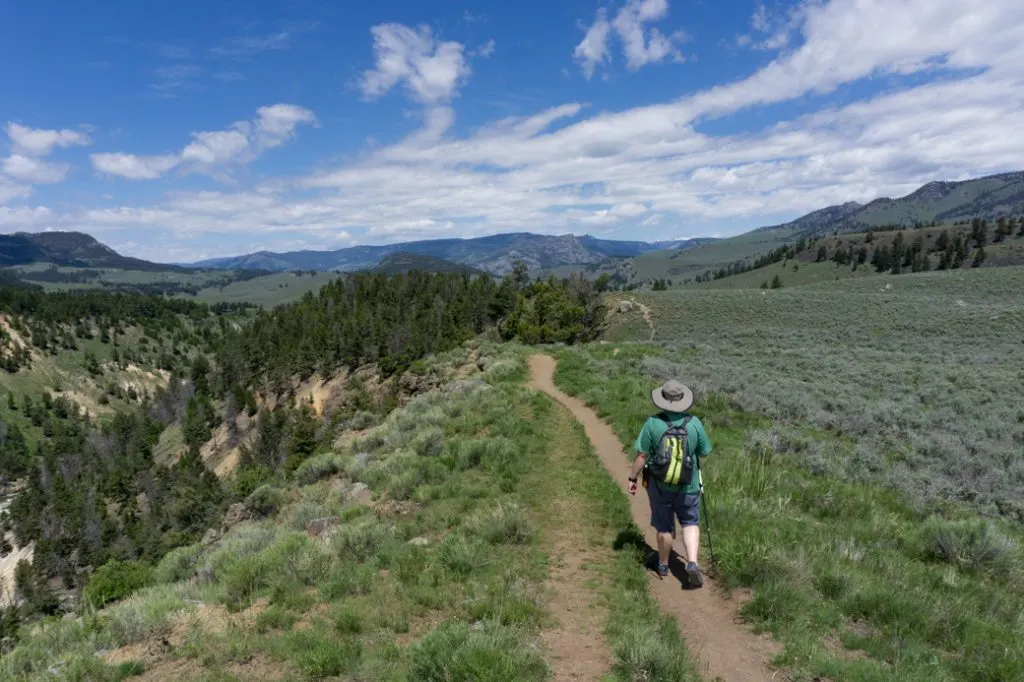
Guidebook and Maps (Optional)
You can get ideas about where to hike from the visitor centres or the park brochure, but I found having a guidebook really helpful. It was great to see all the hike options, then choose one that sounded best to us.
We bought the Yellowstone Trails guide from Yellowstone Forever. (It’s a non-profit organization that supports the park.) Other great options are A Ranger’s Guide to Yellowstone Day Hikes and Hiking Yellowstone National Park.
National Geographic makes the best topographic maps of Yellowstone National Park. They show all the trails. We just brought the general Yellowstone National Park map, but there are smaller, more detailed maps for various park regions too.
Trekking Poles (Optional)
Some trails in Yellowstone have a lot of steep ascents and descents as well as some uneven terrain. Trekking poles can be really helpful for saving your joints on the downhills or keeping your balance in the mud.
I’ve been hiking with poles for the last 15 years and can’t imagine going without them. So of course, I brought my Black Diamond Trail trekking poles to Yellowstone. If you want a budget pair, the Cascade Mountain Tech trekking poles get great reviews.
Yellowstone National Park Picnic Gear
Yes, Yellowstone has restaurants. But they are expensive and many of the attractions far from the nearest restaurant.
We packed a picnic lunch for most of our days in the park. It was a fun way to slow down in the middle of the day and just chill out at a beautiful spot. It was also MUCH less expensive than eating out every day.
Yellowstone National Park has lots of picnic areas with tables and restrooms. Many of them are a little bit off-the-beaten-path so you get to explore some of the quieter parts of the park. Here’s my picnic packing list for Yellowstone:
Groceries and Snacks
There are a few small stores in Yellowstone, but they have very limited groceries. And the prices are expensive! If possible, stock up before you get to the park.
During our trip, we shopped at grocery stores in Gardiner, MT, West Yellowstone, MT and Jackson, WY. They all had a pretty good selection of things at reasonable prices.
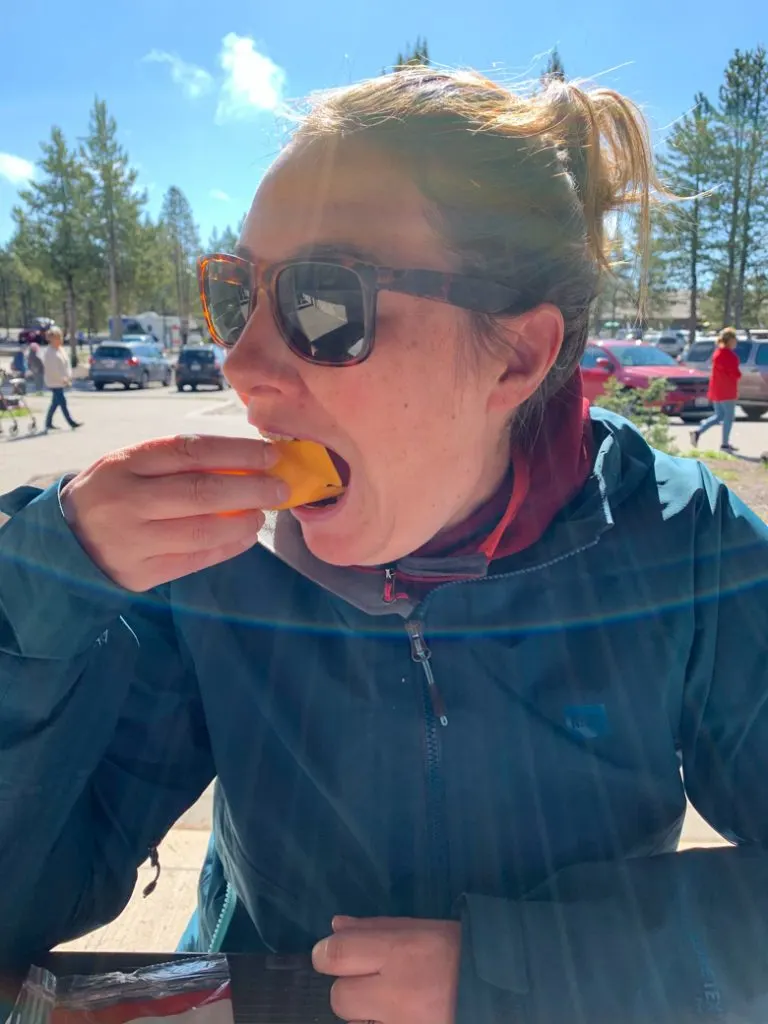
Cooler
It can get really warm in the afternoon in Yellowstone, so a cooler is a must. You don’t need anything super fancy. We have a small 18 quart Coleman cooler. It held ice for a day or so, then we just bought more at the park store.
Since our trip to Yellowstone we splurged and got a YETI Roadie 24 cooler. It’s definitely expensive, but the increase in performance is huge! We’ve used it on tons of trips (including to Moab, Utah) and it holds ice for days and days.
Pro tip: To make your ice last longer, cover your cooler with a warm jacket, blanket, or sleeping bag to provide more insulation and shade when you leave it in a hot car.
Plates, Forks, Cutting Board, and Knife
We brought a couple of camping plates and our trusty camping sporks to eat off of. Having a cutting board and knife to cut up veggies, sausage and cheese was also helpful. We have this cutting board and knife set. It folds in half and the knife stows inside!
Reusable Food Containers and Ziploc Bags
We brought a couple of plastic food containers and a handful of Ziploc bags and they were so helpful. We stored leftovers in them and used them to protect groceries from getting soggy in the cooler.
Table Cloth (Optional)
The one piece of picnic gear that I forgot to bring was a plastic table cloth. I was definitely jealous when I saw other groups using one. They are handy to have to cover less-than-clean picnic tables. And they are easy to wipe down when you’re done. Plus they make you feel a bit fancy!
Yellowstone National Park Camping Gear
One of the best ways to experience Yellowstone National Park is to camp. (I liked it so much I wrote a whole guide with everything you need to know about camping in Yellowstone.)
Most of the crowds go back to their hotels in the evenings and the park really quiets down. You may also get to see more wildlife as some animals like to hang around the campgrounds.
When planning to camp in Yellowstone, keep in mind that all the campsites are above 6000 feet (1800 meters), which means they can be chilly at night, even in the summer. The average low temperature in June, July, and August is between 34 and 39F (1-4C). Brrrr!
As well, afternoon and evening thunderstorms are common, so you’ll want to make sure you are prepared for rain. Use these tips for camping in the rain to make sure you stay dry.
For camping in Yellowstone, bring all the things on my picnic gear list above, plus these items:
Tent
Bring a waterproof tent that can stand up to rain and wind. Choose one with a full-length rain fly that reaches all the way to the ground and covers the door. That offers MUCH more protection than the ones with a little fly on the top.
We brought our MEC Volt 4 tent to Yellowstone and it held up well. Another good option is the REI Base Camp.

Warm Sleeping Bag and Insulated Sleeping Pad
The campsites in Yellowstone are all over 6000 feet (1800m) elevation. Many of them are over 7000 feet (2100m). It can be cold at night up there.
Pack a sleeping bag rated at least 32F (0C). Choose one with a hood for extra warmth. The REI Siesta 20 sleeping bag is a great budget pick that will still keep you warm.
Even the warmest sleeping bag can’t protect you from the cold ground. Sleeping pads don’t just provide comfort – they also provide insulation since you lose heat to the ground.
Choose a sleeping pad that has an R-value of at least 2.5. (R-value measures insulation and warmth). The Sea to Summit Comfort Light sleeping pad is a good budget pick that gives you comfort and warmth.
If you expect really cold weather or know you feel the cold at night, pick a pad with an even higher R-value. I use a Therm-a-rest NeoAir Xtherm since I sleep really cold. A cheaper option is the Big Agnes Rapide SL.
READ NEXT: How to Stay Warm in a Tent: Over 40 Tips
Thermal Base Layer Top and Bottoms
When it’s chilly, I sleep in thermal base layers while camping. They keep me way warmer than regular PJs. They are also nice to wear around the campsite under my clothes on cold evenings and mornings.
Choose mid-weight thermals made of polyester or merino wool and be sure to pack both bottoms and a long sleeved top.
I sleep cold so I wear the Smartwool Classic Thermal Merino Crew top and Smartwool Classic Thermal Merino Base Layer bottoms. If you’re looking for a budget option, the REI Midweight base layer top and REI Midweight base layer bottoms are good.
Warm Hat and Gloves
You lose a lot of heat through your head and hands. Pack a cozy beanie and some lightweight fleece or wool gloves to wear in the evenings.
Headlamp or Flashlight
Pack a headlamp or flashlight to find your way around at night. I like using a headlamp since it keeps my hands free. I use a Fenix HM50R headlamp. It’s super bright and easy to use. Plus the battery is rechargeable and lasts a long time.
Stove, Fuel, Pots and Cooking Utensils
Most campsites in Yellowstone have fire pits, but there can be campfire bans in dry weather. Cooking on a campfire can be fun, but using a stove is much easier and more reliable.
We use a basic Coleman 2 burner stove. The design has been around for decades for good reason – they are simple to use and super-durable.
Dishwashing Basin, Soap and Scrubber
Most of the Yellowstone campgrounds don’t have dishwashing sinks and you aren’t allowed to wash dishes in the restrooms or at the water taps. Instead, they ask you to wash dishes at a basin in your campsite, then dump the soapy water in the restroom toilet.
We didn’t bring a basin so we had to wash our dishes in our largest pot. Next time I’ll definitely bring a wash basin. We saw some campers with this nifty collapsible dish basin. It stows flat when you aren’t using it and has handles for carrying it to a place where you can dump it out. I think I’ll definitely be picking one up for our next trip.
Camping Chairs
Sure, you could sit around your picnic table. But that means you can’t get close your to campfire! You need chairs. We brought our Helinox camping chairs since they pack up super small and are pretty comfortable.
Kitchen Tarp
Most of the campers we saw in Yellowstone didn’t have a kitchen tarp. That meant that on the stormy evenings, they were cooking dinner in the rain.
We brought our lightweight backpacking tarp and strung it up on ropes over our picnic table. It gave us a dry place to eat and cook, which was so nice during the storms. You could also just get a cheap blue poly tarp.
A few groups had fancy free standing kitchen shelters with bug screens. One of those is definitely going on my wish list.
READ NEXT: Camping in Yellowstone: Everything You Need to Know
Things You Shouldn’t Bring to Yellowstone
- Drones: They aren’t allowed in any national park.
- Fancy clothes: You won’t need them. All the restaurants in the park are pretty casual and everyone else will be wearing hiking clothes.
- Elk buglers: It’s against the rules to imitate elk calls or use buglers. You also aren’t allowed to imitate wolf calls.
How Cold Does it Get in Yellowstone? What is the Weather Like?
Yellowstone is in the Rocky Mountains and on average, the park is at an elevation of 8,000 feet (2,400 m). That means that it can be cold, even in the summer. The weather is also very unpredictable and it changes often.
Here is a chart that show’s Yellowstone’s average high and low temperatures for each month as well as the number of days with rain. If you’re camping, keep in mind that the lows are overnight temps.
| Month | Average High | Average Low | Rain |
|---|---|---|---|
| Jan | 28°F | 3°F | 13 days |
| Feb | 31°F | 4°F | 11 days |
| Mar | 39°F | 10°F | 14 days |
| Apr | 46°F | 19°F | 13 days |
| May | 53°F | 28°F | 12 days |
| Jun | 63°F | 34°F | 10 days |
| Jul | 73°F | 39°F | 5 days |
| Aug | 71°F | 37°F | 6 days |
| Sep | 62°F | 31°F | 7 days |
| Oct | 48°F | 24°F | 10 days |
| Nov | 34°F | 13°F | 12 days |
| Dec | 26°F | 4°F | 13 days |
Summer in Yellowstone is generally warm but not hot. Daytime temperatures are around 70°F. Nights are much cooler, especially at high elevations. Expect thunderstorms in the afternoons.
The best general weather forecast is the Yellowstone National Park forecast from NOAA. Don’t use forecasts for nearby towns since they are too far away and at lower elevations.
Since the park is so big, look for a weather forecast for the area you want to visit. I like to use Spotwx to get a forecast for the exact place I’m visiting.
READ NEXT: The Best Weather Apps for Hiking
Final Thoughts
With these Yellowstone packing lists, you should have everything you need to have an awesome trip, whether you are hiking, camping, picnicking or just touring around. If you’ve already been to Yellowstone, what was your one “must-have” item you brought? Tell me in the comments.
MORE YELLOWSTONE POSTS:
- 70 Things to do in Yellowstone National Park
- Everything You Need to Know About Camping in Yellowstone
- Best Hikes in Yellowstone National Park
- 25 Things to do in Grand Teton National Park
MORE ADVICE FOR CAMPERS AND HIKERS:
- Bear Safety for Hikers, Campers and Backpackers
- The 10 Essentials: Things You Should Bring on Every Hike
- 16 Things to do Before a Hike
- How to Stay Warm in a Tent: Over 40 Tips
- 17 Ways to Save Money on Hiking Gear
- The Best (and Worst) Backpacking Meals Reviewed - December 16, 2025
- My Favourite Hiking Gear of 2025 - December 9, 2025
- Best Insulated Skirts For Hiking and Snowshoeing in 2026 - December 5, 2025

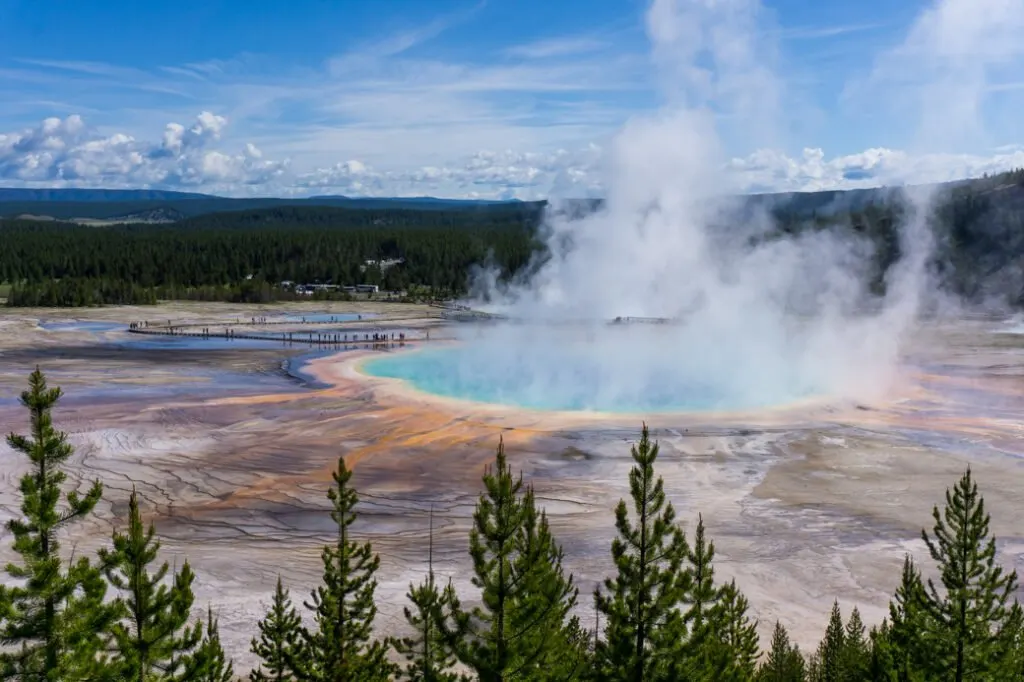
Mia S
Wednesday 22nd of May 2024
hey! i’m going to yellowstone mid june, for 10 days just wondering if i should buy thermals for my trip! thank you so much!
Taryn Eyton
Thursday 23rd of May 2024
Yes, I would bring thermals at any time of year for Yellowstone if you are tent camping. It can get quite cold at night. Look at the temperature info at the bottom of the post to get an idea of how cold it might bet at night.
Brad Dittner
Monday 24th of May 2021
Thank you for all the great info! Taking my family to Yellowstone for our first visit in a month. So excited. Thanks again!
Jen S
Thursday 20th of May 2021
I have the same Sony A6000 camera. Where did you buy the clip to hold your camera on your backpack?
Taryn Eyton
Thursday 20th of May 2021
It's a Peak Design Capture clip. You can buy it directly from Peak Designs or at lots of camera stores.
madhurima chakraborty
Sunday 30th of June 2019
This is a detailed post and does share some light on responsible packing/travel style as well (which I loved). Elk bugler? Seriously? People manufacture that too? Or is it also China made! World and economy and people! The strangest thing they built in this planet, I tell ya!
Ann
Friday 28th of June 2019
This is most definatly on my bucketlist of places to visit!
It looks like a supercool way to spend aa weekend, and I will definatly try to visit in near future, but its quite far away from Stockholm Sweden :)